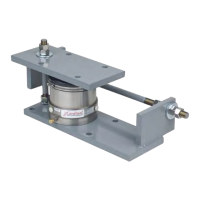1780-M057-O1 Rev C Hydraulic Floor Stand Tank/Hopper
Be sure to leave a loop of tube at each load cell so that the cell can be moved a bit
if necessary and also to allow a tube to be cut off and a new ferrule set installed if
necessary. NEVER attach the tube to the scale weighbridge as the vibration will
lead to fatigue and failure of the tube to load cell connection.
INSTALLATION, CONT.
Next, mount the totalizer enclosure on a wall as close to the digital weight indicator as possible.
The totalizer enclosure should be mounted with at least 24 inches of clearance below it to allow
room to connect the hydraulic tubes running from the cells to the bulkhead fittings. The 2 inch
conduit from the scale should be stubbed up directly under the left side of the totalizer enclosure
for the easiest installation. The totalizer should be located such that it is exposed to the same
temperatures as the load cells. This ensures the proper operation of the temperature
compensation circuits.
After the cells and the totalizer enclosure have been located, the hydraulic tubes must be cut to
length and installed. Always start with the longest runs first and be aware that the drops from
some of the longer runs may be used for shorter runs.
1. Using a sharp tube cutter, cut about one inch off of the end of each tube.
2. Cut only half way through the tube then gently bend the tube back and forth to finish the cut.
This keeps the inside diameter of the tube from collapsing when the cutter breaks through the
tube wall. Use a jeweler’s file to remove any burrs from the end of the tube.
3. Place the nut and inner and outer ferrule over the tube and then assemble it finger tight onto
the load cell or totalizer fitting.
4. Mark the nut so that you can tell where you began tightening the fitting and tighten ¾ to 1 turn.
5. Swagelok makes a simple gage to check the connection, so that if it will slide in between the
fitting and nut, it needs tightend more.
6. If you must remove a fitting, they recommend you mark the nut and fitting so that when you
reassemble the connection you go back to exactly the same place, and then an additional 1/8
to 1/4 turn.
Figure No. 3 – Swagelok Gap Inspection Gauge

